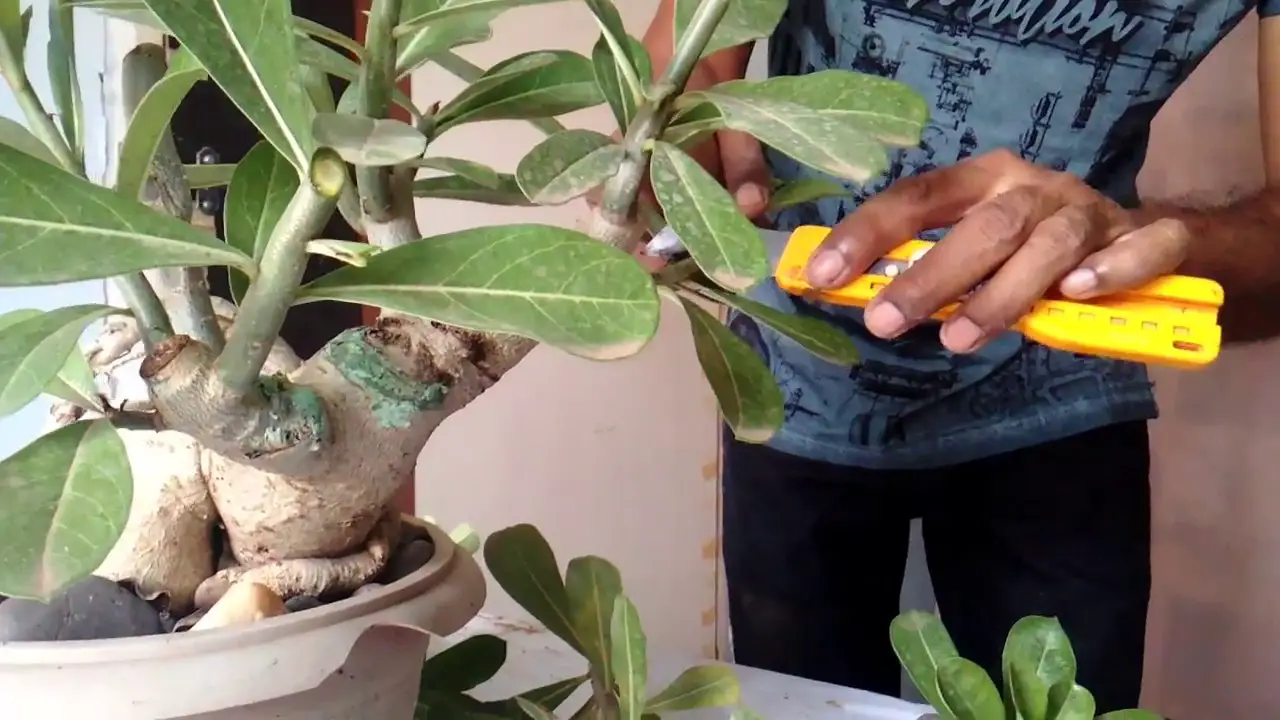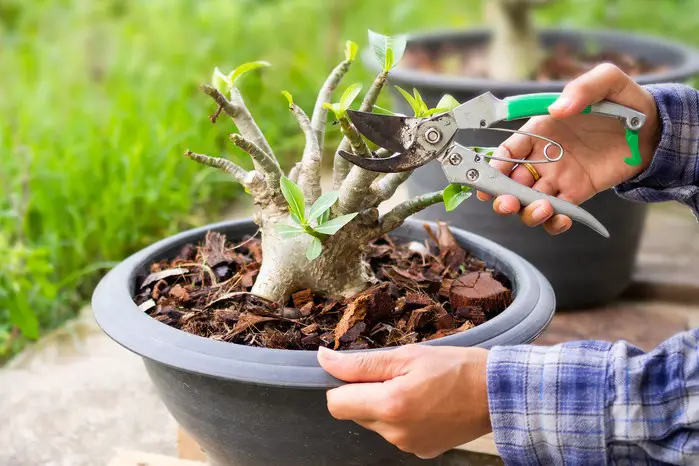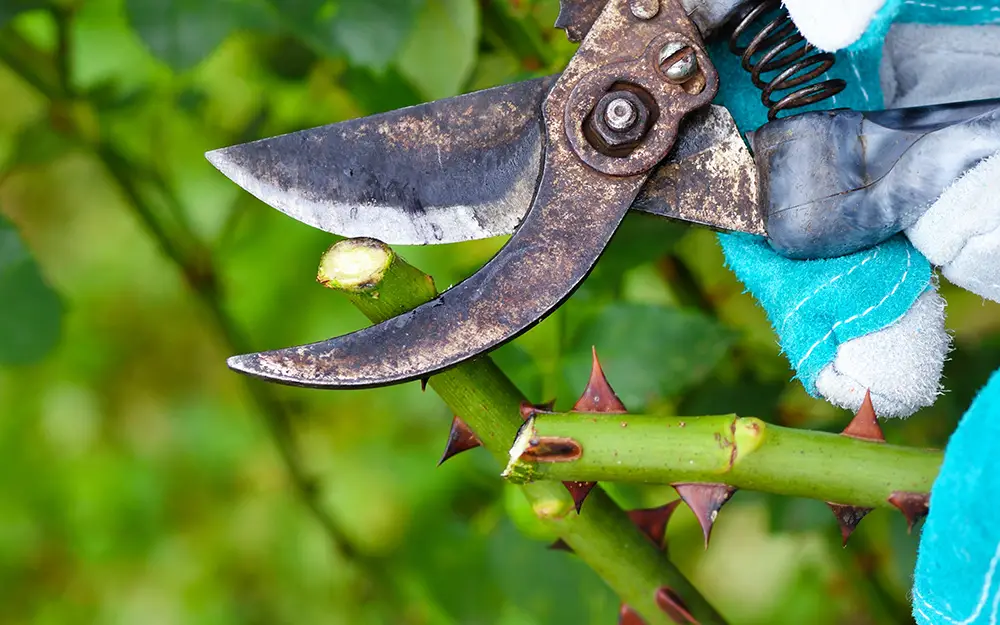The Desert Rose (Adenium obesum) is an impressive plant characterized by succulent stems and vibrant red blooms. The plant is native to arid regions of East Africa and the Arabian Peninsula, where it has evolved an extraordinary ability to store water and thrive in a harsh climate. While the Desert Rose is relatively easy to care for, it does require pruning to ensure that it maintains its attractive shape and remains healthy. Pruning not only encourages bushy growth but also aids in the prevention of diseases. In this guide, we will walk you through pruning a Desert Rose effectively.
How To Prune Desert Rose?
Necessary Tools
Before you begin pruning Desert Rose, it’s crucial to have the right tools on hand. To perform the task, make sure to have a pair of sharp and clean pruning shears or a knife at your disposal, protective gloves, and protective eyewear to prevent any contact with the plant’s toxic sap.

Pruning Procedure
Put on your protective gloves and eyewear. Remember, Desert Rose’s sap is toxic and can cause skin irritation or eye injuries.
Identify the parts of the plant you want to prune. Look for old, diseased, or damaged branches, as well as those that are overcrowding the plant or growing in a way that disrupts its natural form.
With your shears or knife, make clean cuts at a 45-degree angle. This helps the plant heal faster and prevents water from collecting at the cut site, which could lead to rot or disease.
To avoid the transmission of disease from one plant section to another, it is important to sanitize your tool after each cut.
Once you’ve finished pruning, remove all cuttings and debris from the area. If any sap got on your skin, wash the area thoroughly with soap and water.
Aftercare
After trimming, the Desert Rose plant may require additional attention and care. If you’ve made large cuts, consider applying a tree wound dressing to safeguard vulnerable areas from pests and diseases. Keep the plant in a shaded area for a few days to help it recover, and avoid overwatering during this period as the plant’s reduced foliage means it will use less water.[1]
Equipment Needed

To perform effective pruning of the Desert Rose plant, you’ll need a set of specific tools and safety equipment. The key equipment you will need includes:
- Pruning Shears or Knife: A sharp, clean pruning shear or knife is essential for making clean cuts that will heal quickly and minimize damage to the plant.
- Protective Gloves: Wearing gloves is essential for safeguarding your hands from the plant’s toxic sap and preventing any cuts or scratches.
- Protective Eyewear: The Desert Rose’s sap can cause eye injuries. Wearing protective eyewear will safeguard your eyes.
- Dressing for Tree Wounds: If you’re making large cuts on the plant, a tree wound dressing will protect the exposed areas from pests and diseases.
- Disinfectant: Used to clean your tools after each cut, a disinfectant will prevent the spread of disease from one part of the plant to another.
Remember to have all of your equipment on hand before you begin pruning to ensure a safe and efficient process.
Pruning the Branches and Blossoms
Pruning branches and blossoms require careful consideration of timing and technique of Desert Rose can have a big impact on its overall health and appearance. As a general rule, it’s best to prune these parts just after flowering, which usually occurs in the spring or early summer. This allows the plant to recover and store energy for the next blooming cycle.

Begin by identifying the branches that are too long or disrupt the overall shape of the plant. Trim these back, taking care not to remove more than one-third of the branch’s length to avoid causing undue stress to the plant.
For the blossoms, deadhead any spent flowers by cutting them off at the base of the flower stem. This encourages the plant to produce more blooms and diverts energy back into the plant.
Remember to use sharp, clean tools for each cut, and always clean your tools after each use to prevent the potential spread of disease.
Pruning the branches and blossoms of your Desert Rose will not only enhance its visual appeal but also encourage a healthier, more vigorous plant that will reward you with stunning blooms.[3]
Promoting Health through Pruning
Pruning your Desert Rose is not just about improving its aesthetics; it’s also a key step in promoting the overall health of your plant. Regular pruning allows for improved air circulation, reducing the likelihood of fungal diseases caused by damp and stagnant conditions. It also limits the spread of any existing diseases by removing affected parts promptly. Overgrowth can often lead to branches competing for resources — pruning helps to balance this competition, ensuring that all parts of the plant receive an adequate supply of nutrients.

Finally, by eliminating withered or fading blossoms, you enable the plant to channel its energy toward fresh growth and more vibrant blooms. Therefore, a well-pruned Desert Rose is a healthier, more vibrant Desert Rose.
Pruning for Aesthetic Appeal
In addition to promoting health, pruning your Desert Rose also enhances its aesthetic appeal. A well-pruned Desert Rose can be a stunning focal point in your garden, drawing the eye with its unique and sculptural form. Pruning allows you to control the plant’s shape, directing growth in a way that highlights its natural beauty. By trimming back unruly branches, you can maintain a balanced and symmetrical form, making your Desert Rose an architectural delight.
It’s also worth noting that pruning stimulates flowering, leading to more prolific blooms for a more visually striking plant. In essence, the art of pruning is akin to sculpting, allowing you to shape your Desert Rose into a living work of art.[2]
Pruning Tips for Desert Rose Plants
Here are some additional tips to remember when pruning your Desert Rose:
- Timing is key: The optimal timing to prune your Desert Rose is just after flowering, typically in the late spring or early summer. This allows the plant to recover and conserve energy for the next blooming cycle.
- Be gentle: Desert Roses are somewhat delicate, so always prune with a gentle touch. Avoid tearing or ripping the branches, which can cause unnecessary stress and damage.
- Don’t over-prune: While pruning is beneficial, over-pruning can be harmful. To avoid damaging the plant, it is generally recommended not to remove more than one-third of it at once. Excessive pruning can weaken your plant and hinder its growth.
- Consider the plant’s shape: When pruning, always consider the overall shape and look of your Desert Rose. Try to maintain its natural, balanced structure.
- Dispose of cuttings properly: After pruning, dispose of your cuttings properly to prevent disease spread. Never leave cuttings near your plant as they could harbor pests or diseases.
- Clean your tools: Always clean your tools before and after pruning to prevent the spread of diseases. You can use a simple disinfectant or a specialized tool cleaner.
Remember, pruning is an art. With practice and patience, you’ll soon master the skill and have a beautiful, healthy Desert Rose to show for it.[5]
FAQ
When is the best time to trim a desert rose?
The best time to trim a Desert Rose plant is typically after it has finished flowering, which usually occurs in the late spring or early summer. This timing allows the plant to recover and preserve energy for the upcoming cycle of blossoming. To prevent the spread of disease and maintain the health of your plants, promptly remove any branches that are diseased or damaged.
How much can you prune a desert rose?
The extent to which prune a Desert Rose largely depends on the overall health and condition of the plant. However, it is generally advised not to remove more than one-third of the plant at a time as excessive pruning can stress the plant and hinder its growth. To maintain the health of the tree, it is advisable to refrain from pruning more than one-third of a branch’s length when performing branch removal.
This applies to both healthy branches, which you might prune for shaping purposes, and to unhealthy branches, which you might prune to halt the spread of disease. Always remember, the goal of pruning is to enhance the plant’s health and aesthetic appeal, not to weaken or damage it.
Is it better to prune with hand-held tools or an electric trimmer?
In general, hand-held tools are the preferred tool for pruning plants. Electric trimmers can be powerful and can cause more damage than necessary due to their sharp blades. Hand-held tools, such as shears or scissors, allow for more precise cuts and will cause less stress on your Desert Rose.

It is crucial to consistently employ clean and sharp tools when pruning to prevent the spread of diseases. It is also recommended that you disinfect your tools both before and after each use.
Pruning is an art that takes patience and practice to master. [4]
Is it possible to trim a desert rose during the summer season?
Yes, it’s possible to trim a Desert Rose during the summer season, especially if the plant has just finished its blooming cycle. However, pruning during extreme heat can stress the plant, so it’s best to avoid trimming during the hottest parts of the day or a heatwave. Instead, aim for a time when temperatures are milder.
Why is the desert rose growing so tall?
Desert Rose plants may grow tall due to several factors. Firstly, it could be the plant’s genetic predisposition. Some varieties of Desert Rose naturally grow taller than others. Secondly, environmental conditions such as light exposure can play a part. If a Desert Rose is not receiving enough light, it might grow taller as it stretches toward the light source. This is known as etiolation. In addition, a Desert Rose may grow tall if it is over-fertilized, particularly with a fertilizer high in nitrogen, which encourages stem and leaf growth at the expense of flower production.
Lastly, if a Desert Rose is not pruned regularly, it will continue to grow in height. Regular pruning encourages the plant to grow in a more bushy, compact, and balanced manner, instead of just vertical growth.[5]
Do desert roses need shade?
Desert Roses are well-adapted to sunny conditions, being native to arid, desert-like environments. They require plenty of direct sunlight for healthy growth and vibrant flower production. However, they can benefit from light shade during the hottest parts of the day, particularly in climates with intense midday sun. Too much direct sunlight during peak heat can lead to sunburn on the leaves.
If you live in a region with particularly hot summers, providing your Desert Rose with some afternoon shade can help protect it from potential sun damage. So, while Desert Roses are sun-loving plants, some shade during the most intense hours of sunlight is beneficial.
Can desert roses grow from cuttings?
Yes, Desert Roses can indeed grow from cuttings. This is a common propagation method that allows gardeners to produce a new plant that is genetically identical to the parent plant. To grow a Desert Rose from a cutting, start by choosing a healthy, disease-free branch from your plant. Cut a piece about 4 to 6 inches long and let it dry for a few days before planting to allow the cut end to callous over. Once the cutting has dried, plant it in a well-draining soil mix, such as a cactus or succulent mix. Water sparingly until roots start to form, which is typically within a few weeks.
It’s important to remember that cuttings should be taken during warmer months when the plant is actively growing. With proper care, your Desert Rose cutting should develop into a strong, healthy plant.[6]
Is it possible to directly plant rose cuttings into the soil?
Yes, it is possible to directly plant Desert Rose cuttings into the soil. However, it’s highly recommended to allow the cut end to dry and form a callous before planting. This process, which usually takes a few days, helps to prevent the cutting from absorbing too much water and developing rot. Once the cut end has dried, you can plant the cutting directly into a well-draining soil mix. Be sure to water sparingly at first to encourage root development, increasing watering gradually as the plant establishes. Remember, the best time to take cuttings from a Desert Rose is during the warmer months when the plant is actively growing. With patience and proper care, your cutting should thrive and develop into a robust, flowering plant.
What age does pruning end?
Pruning does not necessarily end after a Desert Rose reaches a certain age. Rather, it’s a process that continues throughout the plant’s life to maintain optimal health and aesthetic appeal. Regular pruning can help control the size and shape of your Desert Rose, encourage bushier growth, and remove old or diseased branches. However, as the plant matures, pruning may be needed less frequently as the plant’s growth rate tends to slow down. Always remember that pruning should be done thoughtfully and with care, regardless of the plant’s age.
What is the recommended frequency for pruning in a year?
The recommended frequency for pruning your Desert Rose depends on the specific growth patterns of your plant, as well as its health and the climate in which it’s grown. Generally, a healthy Desert Rose should be pruned at least once a year, typically at the start of the growing season in spring. This allows the plant to focus its energy resources on new growth and flower production during the warmer months.
However, if you notice any diseased or damaged branches, these should be trimmed immediately, irrespective of the time of year. Always remember to use clean, sharp tools to make your cuts and avoid over-pruning — never remove more than one-third of the plant at a time.[2]
What is the maximum number of leaves that I can prune?
When pruning a Desert Rose, there isn’t a specific number of leaves that should be pruned. Rather, the focus should be on the overall health and structure of the plant. Always aim to remove diseased or damaged leaves immediately to prevent the spread of illness and encourage healthier growth. Regular pruning, generally done once a year during the growing season, also helps to shape the plant.
However, it’s crucial to avoid over-pruning. As a rule of thumb, never remove more than one-third of the plant, including leaves, at any given time. This ensures the plant retains enough foliage to perform photosynthesis efficiently and continue robust growth.
What angle do you cut when pruning?
When pruning a Desert Rose, it’s important to make your cuts at a 45-degree angle. This is because an angled cut allows water to run off, preventing moisture buildup that could lead to diseases. Additionally, the 45-degree angle should face away from the plant, promoting the growth of a new branch outwards rather than towards the center of the plant, which could lead to overcrowding. Always ensure that you’re using clean, sharp tools when making the cuts to reduce the risk of damage or infection to the plant. Remember, proper pruning is vital for the health and aesthetic appeal of your Desert Rose.
Does pruning control roots?
Pruning doesn’t directly control root growth in a Desert Rose, but it does affect the plant’s overall energy allocation. When you prune the above-ground portions of the plant, you’re effectively reducing the amount of energy required for maintenance, allowing the plant to divert more resources to root development. However, it’s important to note that excessive or improper pruning can lead to stress and hinder the plant’s growth, including root development. As always, thoughtful and measured pruning is key to promoting the health and vitality of your Desert Rose.[7]
What is a node on a desert rose plant?
A node on a Desert Rose plant is the point on a stem where a leaf or a new branch grows. Nodes are integral to the plant’s growth and development as they’re the sites of new bud formation, which can develop into leaves, branches, or flowers. When pruning, it’s crucial to make your cuts just above a node to encourage new growth and maintain the plant’s health and aesthetic appeal. Understanding the location and function of nodes on your Desert Rose plant can greatly enhance your pruning and propagation practices.
Useful Video: HOW TO PRUNE DESERT ROSE (ADENIUM) EASILY ..
Conclusion
In conclusion, the Desert Rose is an exquisite plant that requires specific care and attention to bloom and flourish. Pruning is an essential part of its maintenance, particularly to shape the plant and manage its growth. While it is possible to prune the plant in the summer, avoid doing so during extreme heat. The height of the Desert Rose can be attributed to various factors, including its genetic predisposition, light exposure, and fertilization. Although the plant loves sunlight, a little shade during intense heat can protect it from damage.
Propagation through cuttings is feasible, and with the right care, these cuttings can grow into vibrant, healthy plants. The Desert Rose is not just a plant, but a testament to the beauty that thrives even in the harshest of conditions.
References:
- https://www.wikihow.com/Prune-Desert-Rose#Pruning-the-Branches-and-Flowers
- https://plantcaretoday.com/pruning-desert-rose.html
- https://backyardfoodgrowing.com/how-to-prune-desert-rose/
- https://www.joyusgarden.com/pruning-adenium/
- https://www.thespruce.com/grow-desert-rose-plants-indoors-1902974
- https://www.gardeningknowhow.com/ornamental/flowers/desert-rose/desert-rose-propagation.htm
- https://backyardfoodgrowing.com/how-to-prune-desert-rose/










Leave a Reply
View Comments